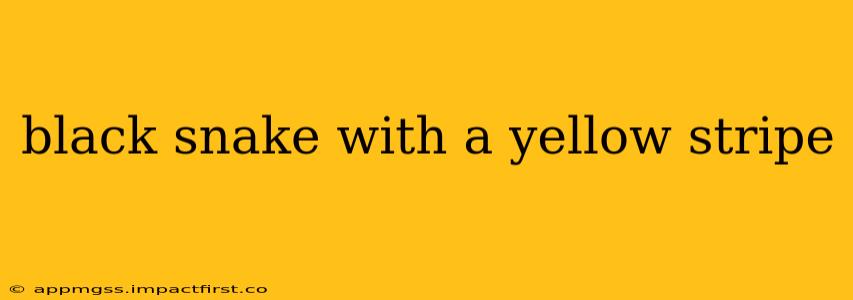The sight of a black snake with a yellow stripe is striking, instantly capturing attention. But which species is it? Several snakes boast this coloration, making identification crucial, especially considering that some are venomous while others are harmless. This guide will help you distinguish between some common black snakes with yellow markings, focusing on key characteristics to ensure safe and accurate identification.
What are some common black snakes with yellow stripes?
This is a crucial question, as several snakes worldwide exhibit this coloration. The specific species will vary depending on geographical location. Some possibilities include:
-
Eastern Yellow-Bellied Racer ( Coluber constrictor flaviventris): This non-venomous snake is frequently found in eastern North America. While its belly is typically yellow, some individuals may display yellow stripes along their sides or backs, particularly when young. They are fast-moving and slender.
-
Yellow-bellied Racer ( Coluber constrictor): This species encompasses several subspecies and variations, some of which exhibit black coloration with yellow accents. Their geographic distribution is wide across North America.
-
Other Potential Species: The specific species of black snake with yellow stripes will depend heavily on the geographic location. Local herpetological societies or wildlife experts can provide region-specific information to narrow down the possibilities. Always exercise caution when attempting identification.
How can I tell the difference between a venomous and non-venomous black snake with yellow stripes?
This is paramount. Never attempt to handle a snake unless you are absolutely certain of its identity and are experienced in handling reptiles. Distinguishing venomous from non-venomous snakes requires careful observation and a solid understanding of local species.
Here are some general guidelines (but remember, these are not foolproof):
-
Head Shape: Venomous snakes often have triangular heads, while non-venomous snakes typically have more rounded or oval heads. However, this is not always reliable.
-
Pupil Shape: Venomous snakes often have elliptical or cat-like pupils, whereas non-venomous snakes usually have round pupils. Again, this is not universally applicable.
-
Body Shape: Venomous snakes may have a more robust build compared to non-venomous snakes.
-
Defensive Behavior: Observe the snake's behavior. A venomous snake might exhibit aggressive defensive behavior such as striking or hissing. However, this is not always indicative of venom.
Critical Note: Relying solely on visual identification to distinguish venomous from non-venomous snakes is risky. If you encounter a snake you suspect is venomous, maintain a safe distance and contact local wildlife experts or herpetologists for assistance.
What should I do if I see a black snake with a yellow stripe?
Your response depends on your comfort level and the snake's behavior.
-
Maintain a safe distance: Do not approach the snake or attempt to handle it.
-
Observe from a distance: If possible, observe its behavior and try to take a photograph (from a safe distance) for later identification.
-
Contact local experts: Reach out to local wildlife agencies, herpetological societies, or professional snake handlers for assistance if you are concerned.
-
Educate yourself: Learn about the native snake species in your area to better understand the potential risks and behaviors.
Are black snakes with yellow stripes dangerous?
The danger posed by a black snake with yellow stripes depends entirely on the species. Some are harmless, while others are venomous. Proper identification is crucial to assess the level of risk. Never assume a snake is harmless based solely on its appearance.
What is the best way to identify a black snake with a yellow stripe?
Combining several identification methods yields the best results:
-
Geographic Location: Knowing the region where you spotted the snake drastically narrows down the possible species.
-
Careful Observation: Note the snake's size, body shape, head shape, pupil shape, and any other distinguishing characteristics.
-
High-Quality Photographs: Clear photographs from a safe distance are invaluable for identification.
-
Expert Consultation: Seeking expert assistance from herpetologists or wildlife professionals ensures accurate identification.
This information is intended for educational purposes only. Never handle a wild snake without proper training and expertise. Always prioritize safety and responsible wildlife observation.
